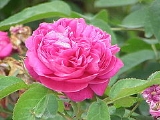
Rosa damascena
Overview
Castile (historical region)
A former kingdom, Castile gradually merged with its neighbours to become the Crown of Castile and later the Kingdom of Spain when united with the Crown of Aragon and the Kingdom of Navarre...
, is a rose
Rose
A rose is a woody perennial of the genus Rosa, within the family Rosaceae. There are over 100 species. They form a group of erect shrubs, and climbing or trailing plants, with stems that are often armed with sharp prickles. Flowers are large and showy, in colours ranging from white through yellows...
hybrid, derived from Rosa gallica
Rosa gallica
Rosa gallica is a species of rose native to southern and central Europe eastwards to Turkey and the Caucasus....
and Rosa moschata
Rosa moschata
Rosa moschata is a species of rose long in cultivation. Its wild origins are uncertain but are suspected to lie in the western Himalayas.-Form:R...
(Huxley 1992). Further DNA analysis has shown that a third species, Rosa fedtschenkoana
Rosa fedtschenkoana
Rosa fedtschenkoana is a species in the plant genus Rosa in the family Rosaceae. It is native to the foothills of the Ala Tau, Tian Shan and Pamir-Alai mountain ranges in central Asia and northwest China. It is named after Olga Fedtschenko, a Russian botanist. It is deciduous, forming a bushy and...
, is associated with the Damask rose.
The flowers are renowned for their fine fragrance, and are commercially harvested for rose oil
Rose oil
Rose oil, meaning either rose otto or rose absolute, is the essential oil extracted from the petals of various types of rose...
(either "rose otto" or "rose absolute") used in perfume
Perfume
Perfume is a mixture of fragrant essential oils and/or aroma compounds, fixatives, and solvents used to give the human body, animals, objects, and living spaces "a pleasant scent"...
ry and to make rose water and "rose concrete".

